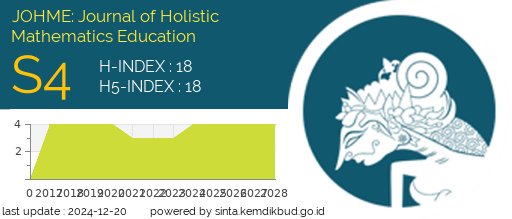A COMPARISON OF GENDER DIFFERENCES TOWARD MATHEMATICS’ COGNITIVE LEARNING OUTCOMES IN A MIDDLE SCHOOL
DOI:
https://doi.org/10.19166/johme.v1i2.804Keywords:
gender difference, learning outcomes, indices, surds, perbedaan gender, hasil belajar, pangkat, akarAbstract
This research examined whether there is any difference of performing mathematics in the topic of Indices & Surds on cognitive learning outcomes between female and male students in grade 9. The research method used was causal-comparative, conducted in t-test for independent means to represent the comparison of mathematics’ cognitive learning outcomes between female and male students, with the significance level 5%. There were 113 respondents who were selected using the convenience sampling technique and they consisted of 68 female students and 45 male students. There were two independent means samples that were going to be compared. The instrument used to obtain students’ demographic characteristics of gender and students’ mathematics cognitive learning outcomes in the topic of Indices & Surds was their score list in midterm report card. Based on the result, it was obtained that 1.69 less than (1.69 < 1.98). Therefore, Ho is accepted, means that there is no mean score differences in mathematics’ cognitive learning outcomes in the topic of Indices & Surds between grade IX female students and grade 9 male students. Thus, the conclusion is that gender as a causal factor in this research gave no difference towards grade 9 students’ cognitive learning outcomes, particularly in mathematics ability in the topic of Indices & Surds in ABC Middle School.
BAHASA INDONESIA ABSTRAK: Tujuan dari penelitian ini adalah untuk melihat apakah ada perbedaan nilai rata-rata dari hasil belajar kognitif matematika pada topik pangkat dan akar antara siswa perempuan kelas IX dan siswa laki-laki kelas IX. Metode penelitian yang digunakan adalah kausal-komparatif, dilaksanakan dengan teknik t-test for independent means untuk merepresentasikan perbandingan hasil belajar kognitif matematika antara siswa laki-laki dan siswa perempuan, dengan taraf signifikansi 5%. Terdapat 113 responden yang dipilih dengan teknik convenience sampling; terdiri dari 68 siswa perempuan dan 45 siswa laki-laki, sebagai dua sample rata-rata independen yang akan dibandingkan. Instrument yang digunakan untuk memperoleh data demografis jenis kelamin siswa dan data hasil belajar kognitif matematika siswa pada topik pangkat dan akar adalah daftar nilai di buku raport tengah semester. Dari hasil penelitian, diperoleh t obt , yaitu 1.69 dimana kurang dari t cv (1.69<1.98). Ho diterima, yang berarti tidak terdapat perbedaan nilai rata-rata dari hasil belajar kognitif matematika pada topik pangkat dan akar antara siswa perempuan kelas IX dan siswa laki-laki kelas IX. Sehingga, dapat diambil kesimpulan bahwa jenis kelamin sebagai kausal faktor dalam penelitian ini tidak memberikan perbedaan terhadap hasil belajar kognitif siswa kelas IX, khususnya dalam kemampuan matematika pada topik pangkat dan akar di Sekolah Menengah ABC.
References
Agah, J. J. & Sule L. (2015). Determinants of students’ logical reasoning and mathematics achievement. Journal of Literature, Languages and Linguistics, 5, 40-43. Retrieved from http://iiste.org/Journals/index.php/JLLL/article/view/17781/18157
Aisyah, S. (2015). Perkembangan peserta didik dan bimbingan belajar. Yogyakarta, Indonesia: Deepublish.
Ardila, A., Matute E., Inozemtseva, O., & Rosselli, M. (2011). Gender differences in cognitive development. Journal of Developmental Psychology, 47(4), 984-990. DOI: http://dx.doi.org/10.1037/a0023819
Bird, C. E., & Rieker, P. P. (2008). Gender and health: The effects of constrained choices and social policies. New York, NY: Cambridge University Press.
Cejka, M. A., & Eagly, A. H. (1999). Gender-stereotypic images of occupations correspond to the sex segregation of employment. Personality and Social Psychology Bulletin, 25(4), 413-423. DOI: https://doi.org/10.1177/0146167299025004002
Eagly, A. H., & Wood, W. (1999). The origins of sex differences in human behavior: Evolved dispositions versus social roles. American psychologist, 54(6), 408-423. DOI: https://doi.org/10.1037//0003-066x.54.6.408
Fennema, E. & Tartre, L. A. (1985) The use of spatial visualization in mathematics by girls and boys. Journal for Research in Mathematics Education, 16(3), 184-206. DOI: https://doi.org/10.2307/748393
Feriyanto. (2018). The ability of students’ mathematical proof in determining validity of argument reviewed from gender differences. Journal of Physics: Conference Series, 947. DOI: https://doi.org/10.1088/1742-6596/947/1/012042
Fraenkel, J. R., & Wallen, N. E. (2008). How to design and evaluate research in education [Wordpress Version]. Retrieved from https://rezkyagungherutomo.files.wordpress.com/2016/09/how-to-design-and-evaluate-research-in-education.pdf
Gallagher, A. M., Mcgillicuddy, A.V., Morely, M., & Cahalan C., (2000). Gender differences in advance mathematical problem solving. Journal of Experimental Child Psychology, 75(3), 165-190. DOI: https://doi.org/10.1006/jecp.1999.2532
Jenkins, A. & Unwin, D. (2001) How to write learning outcomes. Retrieved from http://www.ncgia.ucsb.edu/education/curricula/giscc/units/format/outcomes.html
Kohm, L. M. (2008). A Christian perspective on gender equality. Duke Journal of Gender Law & Policy, 15, 339-363. Retrieved from https://scholarship.law.duke.edu/djglp/vol15/iss1/4/
Lips, H. M. (2005). Sex and gender: An introduction. New York, NY: McGraw-Hill.
Maccoby, E. E., & Jacklin, C. N. (1974). The psychology of sex differences. Palo Alto, CA: Stanford University Press.
Miller, D. I, & Halpern, D. F. (2014). The new science of cognitive sex differences. Trends in Cognitive Sciences, 18(1), 37-45. DOI: https://doi.org/10.1016/j.tics.2013.10.011
Morgan, G. A., Leech, N. L., Gloeckner, G. W., & Barrett, K. C. (2004). SPSS for introductory statistics: Use and interpretation (2nd ed.). Mahwah, NJ: Lawrence Erlbaum Associates.
Mushtaq, F. (2013). Mathematics achievements among high school students in Afghanistan: Gender difference in math achievements. (Doctoral dissertation, Karlstads Universitet). Retrieved from http://www.diva-portal.org/smash/get/diva2:695182/FULLTEXT01.pdf
MZ, Z. A. (2013). Perspektif gender dalam pembelajaran matematika. Marwah, 12, 14-31. DOI: https://doi.org/10.24014/marwah.v12i1.511
National Council of Teachers of Mathematics [NCTM] (2000). Principles and standards for school mathematics. Reston, VA: NCTM.
Paslov, L. S. (2016). Impacting middle school girls’ interest and achievement in math: Research on a piloted pre-engineering program. NERA Conference Proceedings 2016. Retrieved from http://opencommons.uconn.edu/nera-2016/1
Riadi, E. (2014). Metode statistika: Parametrik dan nonparametrik. Tangerang, Indonesia: Pustaka Mandiri.
Samuelsson, M & Samuelsson, J. (2016). Gender differences in boys’ and girls’ perception of teaching and learning mathematics. Open Review of Educational Research, 3(1), 18-34. DOI: https://doi.org/10.1080/23265507.2015.1127770
Subordinate. (1984). Merriam-Webster's dictionary of synonyms. Springfield, MA: Merriam-Webster.
Sudjana, N. (2009). Penilaian hasil proses belajar mengajar. Bandung, Indonesia: Remaja Rosdakarya.
Woodward, K. (2004). Questioning identity: Gender, class, ethnicity. New York, NY: Open University.
Downloads
Published
How to Cite
Issue
Section
License
Authors who publish with this journal agree to the following terms:
1) Authors retain copyright and grant the journal right of first publication with the work simultaneously licensed under a Creative Commons Attribution License (CC-BY-SA 4.0) that allows others to share the work with an acknowledgement of the work's authorship and initial publication in this journal.
2) Authors are able to enter into separate, additional contractual arrangements for the non-exclusive distribution of the journal's published version of the work (e.g., post it to an institutional repository or publish it in a book), with an acknowledgement of its initial publication in this journal.
3) Authors are permitted and encouraged to post their work online (e.g., in institutional repositories or on their website). The final published PDF should be used and bibliographic details that credit the publication in this journal should be included.”










